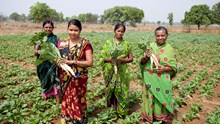
Cotton cultivation is one of India's most crucial cash crops and the backbone of income for numerous farmers. Even though it's a vital crop, cotton production has been continuously declining over the past few years. There are various reasons behind it like poor seed germination, pest attack, diseases, increasing temperatures, and irregular rainfalls. These problems can be overcome and cotton cultivation can become sustainable and profitable with the adoption of modern organic and scientific methods.
India's Major Cotton Growing States
Cotton is largely cultivated in Gujarat, Maharashtra, Madhya Pradesh, Karnataka, Punjab, Haryana, Rajasthan, Tamil Nadu, and Andhra Pradesh. Among these, the top cotton-producing state is Gujarat followed by Maharashtra and then Telangana. In North India, cotton is planted in about April-May, while in the southern states, sowing is done late due to climate variations. Cotton is a Kharif crop and highly rainfall and irrigation-sensitive.
Why Farmers Should Still Choose Cotton
Cotton remains a profitable crop if grown with better practices in spite of its problems. It has a strong domestic and international market demand. Besides the cotton fiber, its seeds are utilized to produce oil and cottonseed cake, which contributes to farmers' income. With integrated crop management, using certified seeds, enhancing soil health, minimizing chemical inputs, and practicing smart irrigation—farmers can get improved yields and can boost their income.
Scientific Approach to Cotton Farming
To ensure profitability and sustainability, cotton farming needs to switch to organic methods from traditional ones. The process should begin with soil analysis, selecting region-suitable high-quality seeds, and paying attention to sowing at the right time. Organic treatment of seeds will help to improve germination. For pest management, neem-based products, pheromone traps, and bio-based protectants used early on will minimize crop loss. Scientific water management is necessary, particularly in the summer when high temperature and low water availability challenge the survival of crops.
Key Challenges in Cotton Farming and Their Solutions
- Poor Seed Germination
Cotton farmers in many regions are facing a major problem of seed germination. The root cause is compact and heavy soils that restrict air and water movement which are both critical for seed germination. Additionally, poor sowing methods and low-quality seeds, lower seed germination levels. As a result, farmers end up planting more seeds per acre, thereby increasing the cost without improving any yield.
Solution:
The application of soil conditioners using Zytonic technology which is a unique biodegradable polymer. It can significantly enhance soil structure, making the soil loose, porous, and full of beneficial microbes. Such soils not only hold water but also provide effective aeration, increasing germination rates by as much as 95%. Due to increased root strength, the crops are well prepared to thrive even under unfavourable climatic conditions.
- Pest and Disease Infestation
Cotton plants are usually damaged by pests like whiteflies, pink bollworms, red spider mites, mealy bugs, and leaf curl virus among other diseases. Among these, the most destructive is the pink bollworm that infests cotton balls from the interior. All these problems are aggravated by monoculture, excessive pesticide application, and cultivating the same variety every year.
Solution:
Neem-based products are great for early pest control. For example, Zytonic Neem, which is developed using microencapsulation technology. It is adhesive in nature and creates an egg-laying-deterrent protective coating for the leaves. Pheromone traps are also available for monitoring and controlling pests without the use of chemicals. Where pesticides are necessary, their effectiveness can be improved upon through Zytonic Active, a formulation enhancer that provides pest protection for longer periods with reduced chemical use.
- Irrigation Problems and Hot Weather
In the north of India, cotton is usually sown in peak summer, when the temperature rises to 40–45°C and the monsoon season has not yet arrived. Maintenance of soil moisture is a big problem, which leads to water and electricity bills becoming very high. In regions where groundwater is limited, it becomes more and more difficult to grow cotton. Apart from this, irregular rainfall due to climate change also affects the yield.
Solution:
Application of Zytonic products in the soil at the time of land preparation can increase water-holding capacity of the soil to a great extent. Even if they have not been applied previously, they can be applied prior to irrigation or rainfall in standing crops. The products enable the crops to grow with minimum water and also minimize damage by heavy rains through efficient water absorption. Foliar sprays such as Zytonic Protection create a thin coat on leaves and trap dew and atmospheric water, hence minimizing the need for irrigation. This is especially ideal in regions with water shortages.
A Way Forward for Cotton Farmers
Cotton farmers in India are at a turning point. While traditional approaches are not meeting the problems of the modern world, sustainable and scientific methods provide a clear way ahead. Farmers may lower expenses while increasing output and revenue by implementing organic products, effective pest control methods, and smart irrigation strategies.
The moment has come for farmers to embrace scientific and technological breakthroughs and move beyond traditional methods. Cotton farming has the potential to once again contribute to the stability and prosperity of India's rural economy with the correct strategy.
















